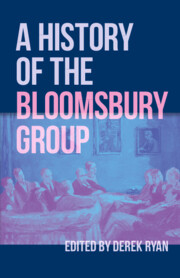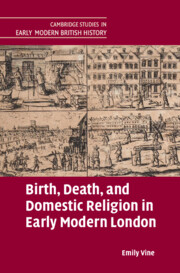Refine search
Actions for selected content:
212 results
Chapter 6 - Staging Utopian Subjects
- from Part II - Building New Communities
-
-
- Book:
- The Cambridge Companion to British Utopian Literature and Culture since 1945
- Published online:
- 18 December 2025
- Print publication:
- 31 December 2025, pp 119-137
-
- Chapter
- Export citation
Chapter 11 - ‘Art Thou Base, Common and Popular?’
- from Part III - ‘One of Us’
-
-
- Book:
- 'The People' and British Literature
- Published online:
- 11 December 2025
- Print publication:
- 11 December 2025, pp 175-188
-
- Chapter
- Export citation
13 - Citizens
- from Part III - The King and His Subjects
-
-
- Book:
- The Cambridge Companion to Late Medieval English Kingship
- Published online:
- 03 November 2025
- Print publication:
- 20 November 2025, pp 257-277
-
- Chapter
- Export citation

A History of the Bloomsbury Group
-
- Published online:
- 09 October 2025
- Print publication:
- 23 October 2025
Chapter 5 - Dying and Deathbed Practices
-
- Book:
- Birth, Death, and Domestic Religion in Early Modern London
- Published online:
- 17 July 2025
- Print publication:
- 31 July 2025, pp 159-188
-
- Chapter
- Export citation
Chapter 3 - Religious Practices Following Childbirth
-
- Book:
- Birth, Death, and Domestic Religion in Early Modern London
- Published online:
- 17 July 2025
- Print publication:
- 31 July 2025, pp 97-124
-
- Chapter
- Export citation
Chapter 6 - Domestic Religion in the Days After Death
-
- Book:
- Birth, Death, and Domestic Religion in Early Modern London
- Published online:
- 17 July 2025
- Print publication:
- 31 July 2025, pp 189-216
-
- Chapter
- Export citation
Chapter 2 - Childbirth, Religious Practice, and Domestic Space
-
- Book:
- Birth, Death, and Domestic Religion in Early Modern London
- Published online:
- 17 July 2025
- Print publication:
- 31 July 2025, pp 64-96
-
- Chapter
- Export citation
Chapter 1 - Domestic Religion in Seventeenth- and Eighteenth-Century London
-
- Book:
- Birth, Death, and Domestic Religion in Early Modern London
- Published online:
- 17 July 2025
- Print publication:
- 31 July 2025, pp 28-63
-
- Chapter
- Export citation
Chapter 4 - Daily Domestic Devotion and Preparation for Death
-
- Book:
- Birth, Death, and Domestic Religion in Early Modern London
- Published online:
- 17 July 2025
- Print publication:
- 31 July 2025, pp 125-158
-
- Chapter
- Export citation
Conclusion
-
- Book:
- Birth, Death, and Domestic Religion in Early Modern London
- Published online:
- 17 July 2025
- Print publication:
- 31 July 2025, pp 217-226
-
- Chapter
- Export citation
Introduction
-
- Book:
- Birth, Death, and Domestic Religion in Early Modern London
- Published online:
- 17 July 2025
- Print publication:
- 31 July 2025, pp 1-27
-
- Chapter
- Export citation

Birth, Death, and Domestic Religion in Early Modern London
-
- Published online:
- 17 July 2025
- Print publication:
- 31 July 2025
Chapter 26 - The English Stage
- from Part IV - Performance Legacies
-
-
- Book:
- Sean O'Casey in Context
- Published online:
- 23 June 2025
- Print publication:
- 10 July 2025, pp 281-296
-
- Chapter
- Export citation
Chapter 18 - Bernard Shaw
- from Part III - Collaborators and Critics
-
-
- Book:
- Sean O'Casey in Context
- Published online:
- 23 June 2025
- Print publication:
- 10 July 2025, pp 192-201
-
- Chapter
- Export citation
Chapter 19 - Eileen Carey (Eileen O’Casey)
- from Part III - Collaborators and Critics
-
-
- Book:
- Sean O'Casey in Context
- Published online:
- 23 June 2025
- Print publication:
- 10 July 2025, pp 202-211
-
- Chapter
- Export citation
Universal in Scope and Appeal? The Politics of ‘National’ vs ‘International’ Opera at Post-war Covent Garden
-
- Journal:
- Transactions of the Royal Historical Society / Volume 3 / December 2025
- Published online by Cambridge University Press:
- 07 July 2025, pp. 229-252
- Print publication:
- December 2025
-
- Article
-
- You have access
- Open access
- HTML
- Export citation
Chapter 8 - Reading against the Grain
-
- Book:
- The Strange History of Samuel Pepys's Diary
- Published online:
- 24 April 2025
- Print publication:
- 24 April 2025, pp 151-176
-
- Chapter
- Export citation
5 - ‘The Challenges of New Markets’
-
- Book:
- The European Art Market and the First World War
- Published online:
- 10 April 2025
- Print publication:
- 17 April 2025, pp 182-203
-
- Chapter
- Export citation
1 - The European Market before 1914
-
- Book:
- The European Art Market and the First World War
- Published online:
- 10 April 2025
- Print publication:
- 17 April 2025, pp 11-65
-
- Chapter
- Export citation
